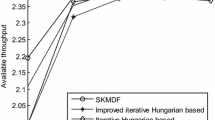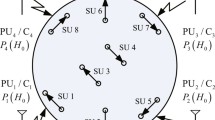Abstract
In this paper, we aim to acquire more spectrum opportunities in a limited sensing time. We construct a novel MAC-layer sensing framework for efficient acquisition of spectrum opportunities. Specifically, we employ the sequential probability ratio test and develop a new collaboration sensing scheme for multiuser to collaborate during multi-slot, in which we effectively utilize the resources of secondary users to sense the channels for efficient acquisition of spectrum opportunities. Subsequently, we formulate the proposed scheme as an optimization problem and derive an optimal solution with low complexity, which is based on dynamic programming theory. Simulation results show that the proposed scheme could offer good performance with efficient acquisition of spectrum opportunities in cognitive radio networks.












Similar content being viewed by others
References
Akyildiz, I. F., Lee, W. Y., Vuran, M. C., & Mohanty, S. (2006). NeXt generation/dynamic spectrum access/cognitive radio wireless networks: A survey. Computer Networks, 50(13), 2127–2159.
Mitola, J. (1999). Cognitive radio for flexible mobile multimedia communications. In Proceedings of IEEE mobile multimedia conference (pp. 3–10).
Haykin, S. (2005). Cognitive radio: Brain-empowered wireless communications. IEEE Journal on Selected Areas in Communications, 23(2), 201–220.
Poor, H. V. (1994). An introduction to signal detection and estimation. New York: Springer.
Kay S. M. (1998). Fundamentals of statistical signal processing: Detection theory. Englewood Cliffs, NJ: Prentice-Hall.
Enserink, S., & Cochran, D. (1994). A cyclostationary feature detector. In Proceedings of 28th Asilomar conference on signals, systems, and computers (pp. 806–810).
Xin, Y., Zhang, H., & Rangarajan, S. (2009). SSCT: A simple sequential spectrum sensing scheme for cognitive radio. In Proceedings of IEEE global telecommunications conference (pp. 1–6).
Shei, Y., & Su, Y. T. (2008). A sequential test based cooperative spectrum sensing scheme for cognitive radios. In Proceedings of 19th IEEE international symposium on personal, indoor and mobile radio communications (pp. 1–5).
Zhao, Q., Tong, L., Swami, A., & Chen, Y. (2007). Decentralized cognitive MAC for opportunistic spectrum access in ad hoc networks: A POMDP framework. IEEE Journal on Selected Areas in Communications, 25(3), 589–600.
Chen, Y., Zhao, Q., & Swami, A. (2008). Joint design and separation principle for opportunistic spectrum access in the presence of sensing errors. IEEE Transactions on Information Theory, 54(5), 2053–2071.
Hoang, A. T., Liang, Y. C., & Zeng, Y. (2010). Adaptive joint scheduling of spectrum sensing and data transmission in cognitive radio networks. IEEE Transactions on Communications, 58(1), 235–246.
Kim, H., & Shin, K. G. (2008). Efficient discovery of spectrum opportunities with MAC-layer sensing in cognitive radio networks. IEEE Transactions on Mobile Computing, 7(5), 533–545.
Kim, H., & Shin, K. G. (2008). Fast discovery of spectrum opportunities in cognitive radio networks. In Proceedings of 3rd IEEE Symposium on New Frontiers in Dynamic Spectrum Access Networks (pp. 1–12).
Kim, S. J., & Giannakis, G. B. (2010). Sequential and cooperative sensing for multi-channel cognitive radios. IEEE Transactions on Signal Processing, 58(8), 4239–4253.
Oksanen, J., Lunden, J., & Koivunen, V. (2012). Reinforcement learning based sensing policy optimization for energy efficient cognitive radio networks. Neurocomputing, 80, 102–110.
Fodor, V., Glaropoulos, I., & Pescosolido, L. (2009). Detecting low-power primary signals via distributed sensing to support opportunistic spectrum access. In Proceedings of IEEE international conference on communications (pp. 1–6).
Digham, F. F., Alouini, M. S., & Simon, M. K. (2007). On the energy detection of unknown signals over fading channels. IEEE Transactions on Wireless Communications, 55(1), 21–24.
Quan, Z., Cui, S., Poor, H., & Sayed, A. (2008). Collaborative wideband sensing for cognitive radios. IEEE Signal Processing Magazine, 25(6), 60–73.
Liang, Y. C., Zeng, Y., Peh, E. C. Y., & Hoang, A. T. (2008). Sensing-throughput tradeoff for cognitive radio networks. IEEE Transactions on Wireless Communications, 7(4), 1326–1337.
Wald, A. (1945). Sequential tests of statistical hypothesis. Annals of Mathematical Statistics, 16(2), 117–186.
Bellman, R. (1962). Applied dynamic programming. Princeton, NJ: Princeton University Press.
Larson, R. E. & Casti, J. L. (1978). Principles of dynamic programming. Part I: Basic analytic and computational methods. New York: Marcel Dekker.
Hata, M. (1980). Empirical formula for propagation loss in land mobile radio services. IEEE Transactions on Vehicular Technology, 29(3), 317–325.
Truncated Normal Distribution, [Online]. Available on February 23, 2012 as http://en.wikipedia.org/wiki/Truncated_normal_distribution.
Peh, E., & Liang, Y. C. (2007). Optimization for cooperative sensing in cognitive radio networks. In Proceedings of IEEE wireless communication and networking conference (pp. 27–32).
Acknowledgments
This work was funded by the Project-sponsored by SRF for ROCS, SEM, the National and Major Project with Grant 2012ZX03003004, the National Natural Science Foundation of China with Grants 61172052 and 60872008, the Program for New Century Excellent Talents in University of China under Grant NCET-08-0217, and Science Found for Distinguished Young Scholars of Hubei in China with Grant 2010CDA083.
Author information
Authors and Affiliations
Corresponding author
Appendices
Appendix 1: Proof of L(t ik )
Based on (2), the probability density function (PDF) of t ik can be obtained by
where u 0 and σ 20 are the mean and variance of t ik under H i0, and \(u_0 = \sigma _v^2, \sigma _0^2 =\frac{\sigma _v^4 } {S}\), u 1 and σ 21 are the mean and variance of t ik under H i1, and u 1 = σ 2 v (1 + γ k ), \(\sigma _1^2 = \frac{\sigma _v^4} {S}(1 + 2\gamma_k )\).
Then, the LLR of t ik is obtained by
where \(A_k = \frac{1}{2\sigma _0^2} - \frac{1}{2\sigma _1^2 } = \frac{S\gamma_k}{\sigma _v^4 \left( 1 + 2\gamma_k\right)},\; B_k = \frac{u_0}{\sigma _0^2} - \frac{u_1}{\sigma _1^2 } = \frac{S\gamma_k}{\sigma _v^2 \left( 1 +2\gamma_k \right)},\; C_k = \ln \frac{\sigma_0}{\sigma _1} + \left( \frac{u_0^2 } {2\sigma_0^2} - \frac{u_1^2} {2\sigma_1^2} \right) = - \frac{1}{2}\ln \left( 1 + 2\gamma_k \right) - \frac{S\gamma_k^2} {2\left( 1 + 2\gamma_k \right)} \).
\(A_k(t_{ik} - \frac{B_k}{2A_k}) ^2\) has the non-central chi-square distribution since t ik has the normal distribution and A k , B k , C k are constant for certain SU. The mean and variance of the corresponding normal distribution are
Hence, the proof is completed.\(\square\)
Appendix 2: Derivation of \(P\left( \sum\nolimits_{k = 1}^{U_i } {T_{ik} } < \ln \eta _0 - \xi_i \right)\)
Let F denote \(P\left( \sum\nolimits_{k = 1}^{U_i } {T_{ik} } < \ln \eta _0 - \xi_i \right). \) From (17), we can obtain
where \(D_i=\ln \eta _0 - \xi_i + \sum\limits_{k = 1}^{U_i } {\left( \frac{B_k^2} {4A_k} - C_k \right)}. \) Let X k denote \(A_k \left( t_{ik} - \frac{B_k} {2A_k} \right)^2\) and Y i denote \(\sum\limits_{k = 1}^{U_i } {X_k}. \) From Appendix 1, we know X k has the non-central chi-square distribution with freedom 1. Hence, we can easily obtain the characteristic functions of random variable Y i when we assume the random variables X k are statistically independent
where \(\phi _{X_k } \left( jv\right) = \left(1 - j2v\sigma _{k}^2 \right)^{ - \frac{1}{2}} \exp \left( \frac{jvm_{k}^2 }{\left( 1 - j2v\sigma _{k}^2 \right)} \right)\) is the characteristic function of X k , σ 2 k and m 2 k can be obtained by (18).
Then, the probability density function (PDF) of Y i is obtained by
and F can be obtained by
For a Rayleigh fading channel, γ k has an exponential probability density function (PDF) with the parameter γ which is the average of γ k . As illustrated in Fig. 1, the distances among SUs are much smaller than the distances between SUs and PU in our considered scenario. Hence, it is reasonable to assume that all SUs have the same average SNR γ [25]. However, it is still difficult to compute F in (22). We try to approximate F in (22) by using the average SNR γ instead of the SNR of the kth SU \(\gamma_k,\, k=1, 2,\ldots, M. \) Then, the approximate Y i , denoted as \(\bar{Y}_i, \) has the non-central chi-square distribution with freedom U i , and \(\bar{F}\) can be obtained by
To evaluate the gap between F and \(\bar{F}, \) we obtain the cumulative distribution function (CDF) of F via Monte Carlo searching, and \(\bar{F}\) via the CDF of non-central chi-square distribution, respectively. In this simulation, we consider one idle channel and the average SNR γ = −10 dB. As shown in Fig. 13, the CDFs of F and \(\bar{F}\) match well under U i = 10, 30, which illustrates that \(\bar{F}\) could approximate F well.
In addition, when the channel has not been determined, it is reasonable to assume that the channel is idle with probability P a and busy with probability 1 − P a , where P a is the probability of each channel being available. We also evaluate the performance loss if P a cannot be estimated exactly in Sect. 5. Then, \(\bar{F}\) can be obtained by
where \(P\left( \bar{Y}_i < \bar{D}_i |H_{i0} \right)\) and \(P\left( \bar{Y}_i < \bar{D}_i |H_{i1}\right)\) could be easily obtained by the CDF of non-central chi-square distribution (the corresponding parameters of the non-central chi-square distribution could be obtained by (18)).
Hence, the expression of \(P\left( \sum\nolimits_{k = 1}^{U_i} {T_{ik} } < \ln \eta _0 - \xi_i \right)\) in (9) is obtained.
Rights and permissions
About this article
Cite this article
Wang, Z., Qu, D. & Jiang, T. Novel adaptive collaboration sensing for efficient acquisition of spectrum opportunities in cognitive radio networks. Wireless Netw 19, 247–258 (2013). https://doi.org/10.1007/s11276-012-0463-y
Published:
Issue Date:
DOI: https://doi.org/10.1007/s11276-012-0463-y





